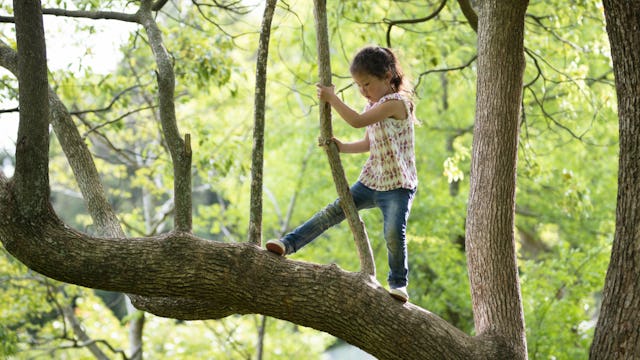Science Says: Let Your Kids Take Risks While Playing. It's Good For Them.

When we imagine learning environments for our kids, we don’t typically think of letting them play with sharp saws or starting a fire. But research suggests that we’re doing our kids a disservice by keeping them from outdoor environments we consider “risky.”
“Risky play” refers to unstructured environments where there are perceived elements of danger. It includes rough-and-tumble play, playing at great heights or fast speeds, playing with potentially harmful tools or near dangerous elements (such as fire), or play where children can “disappear” or get lost.
As parents, we’ll do whatever we can to keep our kids safe. We don’t want anyone to get hurt or lost, especially considering our kids don’t even seem to understand what the words “Be careful” mean.
But this research says there are benefits to parents getting out of the way and letting kids manage risky outdoor play on their own.
1. Risky play helps kids develop social skills, creativity, and resilience.
Through these activities, kids exercise their ability to assess risk levels. They learn what’s safe and what’s not. They make quick judgments. Risky outdoor play provides a unique environment where kids figure out how the world works, learn to work well with others, and find creative solutions to problems.
2. It can also help children build self-esteem.
If a child is told they cannot engage in activities that are deemed risky, they will likely develop doubts about their own abilities.
Children who engage in risky play are more likely to experience positive emotions such as enjoyment, excitement, pride, and self-confidence. By allowing kids to participate in risky play, we are demonstrating that we trust them and they’re capable of problem-solving on their own. This can have profound effects on a child’s self-esteem.
3. Preventing our kids from participating in risky play has unintended negative consequences.
Alternatively, children who aren’t exposed to risky play may feel less self-confident and more vulnerable. This lack of confidence can affect their development in other ways, including increased sedentary behavior, anxiety, and phobias.
4. Risky play is safer than we think it is.
We want our children to have the benefits that come with taking risks, but without having to take anyone to the emergency room. But risky outdoor environments are not as “risky” as we think they are.
There were no serious injuries (to the head or spine) sustained over the course of these studies. In fact, injury incidence rates for risky outdoor play were lower than those for sports and active transportation, ranging from 0.15–0.17 injuries per 1,000 hours of play, which means that Little League baseball or pee wee football might be more dangerous than some other activities we would typically categorize as risky.
Risky play is good for children’s social and physical health, partly because it promotes healthy, active lifestyles and increased playtime.
5. Girls are less likely to be exposed to the benefits of risky play.
Another interesting finding from these studies is that we’re teaching girls to be scared. Parents of boys are more likely to encourage their kids to participate in risk-taking activities than parents of girls.
Parenting practices toward boys include greater exploratory boundaries and less restrictive behaviors than parenting practices toward girls who are being taught that they’re more vulnerable than their male counterparts. This means girls are less likely to experience the social and physical benefits that come with risky play. This is an area we need to improve, clearly.
Children develop best when we educate and encourage them to embrace challenges rather than trying to shield them. When we allow our kids to take risks, they might even surprise us with how well they thrive when trusted with that responsibility.
For more information on how you can support your children by providing them safe, age-appropriate opportunities to participate in risky play, visit OutsidePlay.ca.
This article was originally published on